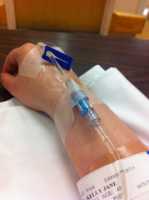Even With Reduced Permits, Hiking Yosemite’s Half Dome Just as Dangerous
Trailhead quotas are often used in national parks to limit the number of visitors and provide opportunities for solitude, but...
Trailhead quotas are often used in national parks to limit the number of visitors and provide opportunities for solitude, but...
MedicalResearch.com Interview with: Daniel J. Lane PhD
Daniel J. Lane PhD
Institute of Health Policy, Management and Evaluation
Dalla Lana School of Public Health, University of Toronto
Rescu, Li Ka Shing Knowledge Institute, St Michael’s Hospital
Toronto, Ontario, Canada
MedicalResearch.com: What is the background for this study? What are the main findings?
Response: Early resuscitation and early antibiotics have become the mainstay treatment for patients with sepsis. The time to initiation of these treatments is thought to be an important factor in patients surviving their disease; however, the independent benefits or harms of intravenous fluid resuscitation, in particular a more aggressive versus more conservative approach to this therapy, remains difficult to evaluate given the concurrent use of these therapies in hospital.
To gain a better understanding of this treatment independent of antibiotic use, we assessed intravenous fluid resuscitation by paramedics on the in-hospital mortality of patients with sepsis. By accounting for the interaction between initial systolic blood pressure and the treatment, we found that earlier resuscitation by paramedics was associated with decreased mortality in patients with low initial blood pressures but not associated with mortality for patients with normal or higher initial blood pressures.
 Dr. Raymond E. Bertino, MD
airRx lead developer and
Clinical Professor of Radiology and Surgery at UICOMP
MedicalResearch.com: What is the background for the airRX app and study?
Response: With increasing air travel, in-flight medical emergencies have increased and physicians on commercial airline flights are routinely asked to volunteer assistance. A study presented this week at the annual meeting of The Society for Academic Emergency Medicine (SAEM) examined physician performance during practice simulations of in-flight medical emergencies with use of a smartphone app, airRx.
In the unique study, cases based on commonly occurring in-flight medical emergencies were portrayed in a mockup of the airline cabin setting. Actors portrayed patients, family members, seat neighbors and flight attendants. Resident physicians in non-emergency specialties were asked to assist as if they were volunteering in actual medical emergencies.
The study utilized airRx, the mobile app developed to help physicians and other medical personnel volunteering during in-flight medical events. The airRx app enables healthcare professionals to access 23 scenarios of the most common medical emergencies, with concise treatment algorithms and reference information to help evaluate and treat the patient. (more…)
Dr. Raymond E. Bertino, MD
airRx lead developer and
Clinical Professor of Radiology and Surgery at UICOMP
MedicalResearch.com: What is the background for the airRX app and study?
Response: With increasing air travel, in-flight medical emergencies have increased and physicians on commercial airline flights are routinely asked to volunteer assistance. A study presented this week at the annual meeting of The Society for Academic Emergency Medicine (SAEM) examined physician performance during practice simulations of in-flight medical emergencies with use of a smartphone app, airRx.
In the unique study, cases based on commonly occurring in-flight medical emergencies were portrayed in a mockup of the airline cabin setting. Actors portrayed patients, family members, seat neighbors and flight attendants. Resident physicians in non-emergency specialties were asked to assist as if they were volunteering in actual medical emergencies.
The study utilized airRx, the mobile app developed to help physicians and other medical personnel volunteering during in-flight medical events. The airRx app enables healthcare professionals to access 23 scenarios of the most common medical emergencies, with concise treatment algorithms and reference information to help evaluate and treat the patient. (more…) MedicalResearch.com Interview with:
Heidi Mochari-Greenberger Ph.D., M.P.H
Associate research scientist
Columbia University Medical Center
New York, N.Y
MedicalResearch: What is the background for this study?
Dr. Mochari-Greenberger: Differences in activation of emergency medical services (EMS) may contribute to race/ethnic and sex disparities in stroke outcomes. The purpose of this study was to determine whether EMS use varied by race/ethnicity or sex among a contemporary, diverse national sample of hospitalized acute stroke patients.
MedicalResearch: What are the main findings?
Dr. Mochari-Greenberger: Use of EMS transport among hospitalized stroke patients was less than 60% and varied by race/ethnicity and sex; EMS use was highest among white females and lowest among Hispanic males. Our analyses showed that Hispanic and Asian men and women were significantly less likely than their white counterparts to use EMS; black females were less likely than white females to use EMS, but black men had a similar rate to white men. These observed associations between race/ethnicity and sex with EMS use persisted after adjustment for stroke symptoms and other factors known to be associated with EMS use, indicating they were not driven solely by stroke symptom differences.
(more…)
MedicalResearch.com Interview with:
Heidi Mochari-Greenberger Ph.D., M.P.H
Associate research scientist
Columbia University Medical Center
New York, N.Y
MedicalResearch: What is the background for this study?
Dr. Mochari-Greenberger: Differences in activation of emergency medical services (EMS) may contribute to race/ethnic and sex disparities in stroke outcomes. The purpose of this study was to determine whether EMS use varied by race/ethnicity or sex among a contemporary, diverse national sample of hospitalized acute stroke patients.
MedicalResearch: What are the main findings?
Dr. Mochari-Greenberger: Use of EMS transport among hospitalized stroke patients was less than 60% and varied by race/ethnicity and sex; EMS use was highest among white females and lowest among Hispanic males. Our analyses showed that Hispanic and Asian men and women were significantly less likely than their white counterparts to use EMS; black females were less likely than white females to use EMS, but black men had a similar rate to white men. These observed associations between race/ethnicity and sex with EMS use persisted after adjustment for stroke symptoms and other factors known to be associated with EMS use, indicating they were not driven solely by stroke symptom differences.
(more…)